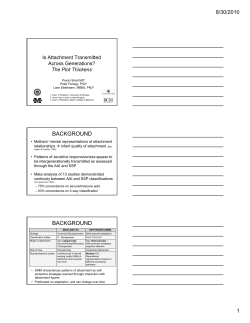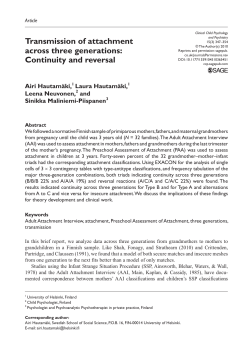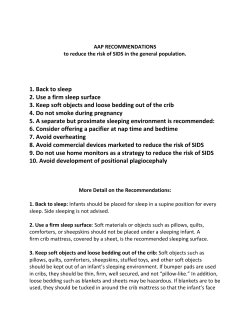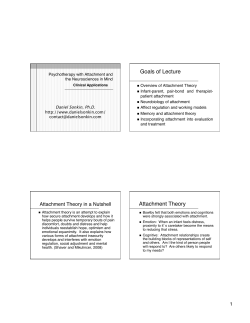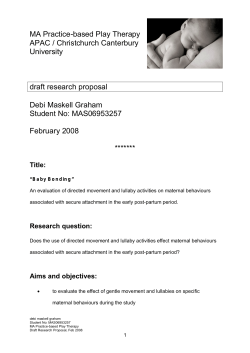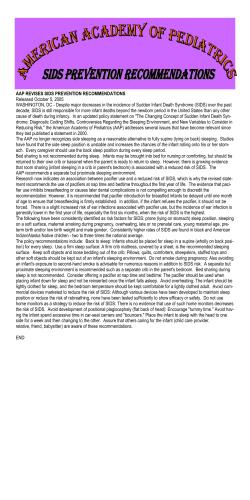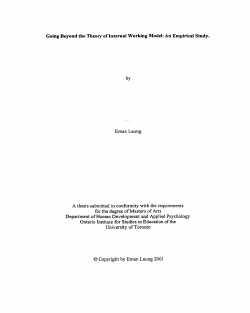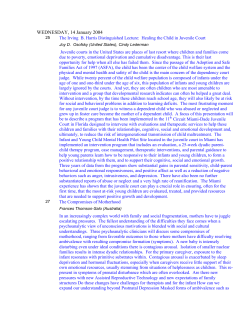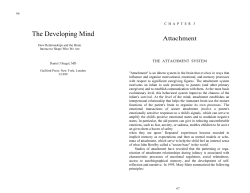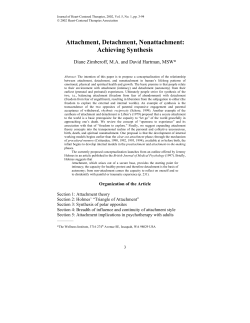
Clinical Child Psychology and Psychiatry
Clinical Child Psychology and Psychiatry http://ccp.sagepub.com/ Is attachment transmitted across generations? The plot thickens Prachi E. Shah, Peter Fonagy and Lane Strathearn Clin Child Psychol Psychiatry 2010 15: 329 DOI: 10.1177/1359104510365449 The online version of this article can be found at: http://ccp.sagepub.com/content/15/3/329 Published by: http://www.sagepublications.com Additional services and information for Clinical Child Psychology and Psychiatry can be found at: Email Alerts: http://ccp.sagepub.com/cgi/alerts Subscriptions: http://ccp.sagepub.com/subscriptions Reprints: http://www.sagepub.com/journalsReprints.nav Permissions: http://www.sagepub.com/journalsPermissions.nav Citations: http://ccp.sagepub.com/content/15/3/329.refs.html Downloaded from ccp.sagepub.com at Goteborgs Univ.- bibliotek on January 27, 2011 Article Is attachment transmitted across generations? The plot thickens Clinical Child Psychology and Psychiatry 15(3) 329–345 © The Author(s) 2010 Reprints and permission: sagepub. co.uk/journalsPermissions.nav DOI: 10.1177/1359104510365449 ccp.sagepub.com Prachi E. Shah,1 Peter Fonagy,2 and Lane Strathearn3 Abstract Studies have demonstrated a strong relation between adult attachment security, using the Adult Attachment Interview (AAI), and infant security, using the Strange Situation Procedure (SSP). This suggests that a mother’s representations of attachment may influence the development of her infant’s attachment to her. This study both confirms and modifies that finding in a cohort of 47 first-time mothers and their infants. The AAIs were administered during the third trimester of pregnancy and the SSPs were performed when the infant was 14 months of age. The AAIs were classified using Crittenden’s Dynamic-Maturational Model (DMM) and the SSPs using both the DMM and also Main and Solomon’s ABC+D methods.There was a significant match of patterns for secure mothers and babies, but a tendency for inversion of insecure patterns of attachment, that is Type A mothers often had infants with a Type C pattern and vice versa. No significant relation was seen between the DMM adult and ABC+D infant patterns of attachment. A significant, but modest, association was found between the DMM and ABC+D infant SSP classifications.These findings may help guide treatment of insecure mother–infant dyads by individualizing interventions to include a focus on maternal representations of the infant and maternal responses to infant behavior. Keywords AAI, attachment, DMM, intergenerational, transmission A central hypothesis in Main’s approach to attachment theory is that mothers’ mental representations of attachment relationships are an important predictor of infants’ quality of attachment (Main, Kaplan, & Cassidy, 1985). That is, patterns of sensitive responsiveness appear to be intergenerationally transmitted, as assessed through the Adult Attachment Interview (AAI; George, Kaplan, & Main, 1985), and the Strange Situation Procedure (SSP; Ainsworth, Blehar, Waters, & Wall, 1978). 1 University of Michigan, Ann Arbor, USA Anna Freud Institute, UK 3 Baylor College of Medicine, USA 2 Corresponding author: Prachi E. Shah, MD, Center for Human Growth and Development, University of Michigan, 300 N Ingalls St, Suite 1056, Ann Arbor, MI 48109. E-mail: [email protected] Downloaded from ccp.sagepub.com at Goteborgs Univ.- bibliotek on January 27, 2011 330 Clinical Child Psychology and Psychiatry 15(3) However, evidence for continuity of attachment from mother to infant is more robust for secure attachment than for anxious (insecure) attachment. In a meta-analysis of 661 dyads in 13 studies, van IJzendoorn (1995) found that 75% of mothers and infants had matching secure versus insecure classifications. However, when a four-way classification (secure, avoidant, ambivalent, and disorganized) was tested, mother–infant agreement dropped to 63% with even less agreement seen for insecure attachment groups. This suggests that the intergenerational transmission of attachment may be more complex than a direct replication of the mother’s pattern, and that the patterns of infant and adult attachment might be multi-dimensional. We explored these possibilities in a longitudinal study of first-time mothers on whom we have prenatal maternal representations and infant–mother attachment at 14 months. We address both conceptual and methodological issues to understand whether and how patterns of attachment are “transmitted” from mothers to their infants. Two expansions of attachment theory and Ainsworth’s classificatory system Following Ainsworth’s groundbreaking work in the 1970s establishing a predictive association between maternal sensitive responsiveness during the first year of life and infant–mother attachment at 11 months (Ainsworth et al., 1978), attention turned to attachment in risk populations and at older ages. In the early reports, many maltreated infants (cf. Crittenden, 1985; Egeland & Sroufe, 1981) and 13% of infants in low-risk samples (Main & Solomon, 1990) were found to be unclassifiable in the SSP according to Ainsworth’s original classificatory method. In both cases, there appeared to be an over-assignment of infants to Type B, secure attachment. To resolve this problem, two of Ainsworth’s students, Mary Main and Patricia Crittenden, expanded Ainsworth’s classificatory system by developing new categories and coding guidelines. The differences in their approaches permit us to explore the intergenerational transmission of attachment in greater detail than in previous studies. Continuity and disorganization. The better known approach is Main’s addition of a fourth category called “disorganized” attachment in infancy (Type D) (Main & Solomon, 1990) and “unresolved” and “cannot classify” in adulthood (Hesse, 1996; Main, 2000). Main proposed that having a frightened or frightening mother made it impossible for the infant to organize a coherent pattern of attachment (cf. Main, 1996). Disorganization was initially described in a normative sample of 12-month-old infants who demonstrated conflicted or anomalous behavior during reunions in the Strange Situation (Main & Solomon, 1990). For Main, the infant’s anomalous behavior reflected the lack of a strategy to manage fear associated with the caregiver’s frightening behavior: the infant’s fear could not be deactivated by a shift in attention (Ainsworth’s A (avoidant) pattern), nor could it be ameliorated though approaching the caregiver (Ainsworth’s B (secure) and C (ambivalent) patterns). Furthermore, Main theorized that the caregiver’s frightening behavior was connected with a history of unresolved loss or trauma (Main & Hesse, 1990). The parent’s representational processes and response to memories became a central focus of Main’s subsequent work in attachment. The Adult Attachment Interview (George et al., 1985) was developed to ascertain caregivers’ states of mind with respect to attachment. The coding system for the AAI was constructed to maximize the correspondence between AAI classifications and infants’ pre-existing SSP classifications based on Main’s beliefs in: (1) the “transmission” of attachment from mother to infant; and (2) the continuity of attachment across the lifespan (Main, 2000; Main et al., 1985). The coding method was developed by searching for commonalities in the interview responses of mothers whose infants shared the same attachment classification. Consequently, in the Downloaded from ccp.sagepub.com at Goteborgs Univ.- bibliotek on January 27, 2011 331 Shah et al. AAI coding system (Main & Goldwyn, 1985–1994), the array of classifications was almost the same as in infancy albeit relabeled. Blind coding of AAI interviews using the Main and Goldwyn method (M&G-AAI) matched Strange Situation coding of security versus insecurity in 75% of cases (Main et al., 1985). In addition, following Bowlby (1980), Main proposed that each individual had one enduring “inner working model” (IWM) of attachment. When individuals were not able to form a single model, or they oscillated among models, it was treated as disorganization. We label this approach which is focused on continuity and disorganization as “ABC+D”. Dynamic-Maturational Model (DMM). Concurrent with the development of the continuityand-disorganization expansion of Ainsworth’s work, Crittenden developed an expansion predicated on different ideas. She believed that, with maturation of the brain, more sophisticated strategies could develop in a dynamic interaction with on-going experience; these strategies were described in a series of papers (e.g., Crittenden, 1981, 1985, 2008; Crittenden & Ainsworth, 1989). In Crittenden’s model, patterns of attachment were considered to be “self-protective strategies” that varied dimensionally (rather than categorically) in terms of the relative use of cognitive-contingent information or affect-arousing information to organize behavior. Furthermore, each individual was thought to have multiple representations based on different processing pathways (i.e., memory systems; Schacter & Tulving, 1994); these were called “dispositional representations” (DRs), with the possibility that different DRs could regulate behavior under different conditions. The degree of integration among the DRs was the other dimension in her model. Crittenden expected threatened children and adults to show organized attachment strategies that reflected more complex Type A and C organizations than Ainsworth’s A1–2, B, and C1–2 patterns. The new patterns were numbered A3–8 and C3–8 and included organized A/C combinations (Crittenden, 1985; Radke-Yarrow, Cummings, Kuczynski, & Chapman, 1985). There was no “disorganized” category and, in fact, fear was treated as a powerful organizing affect (cf. Ledoux, 1996). This differs from Main, who considered fear a disorganizing mechanism (Main & Hesse, 1990). Further, events occurring after infancy could affect a person’s strategy; that is attachment was biased toward constancy, but could change if the environment changed (Crittenden, 2000a; Hamilton, 2000; Lewis, Fearing, & Rosenthal, 2000; Thompson & Raikes, 2003; Weinfeld, Sroufe, & Egeland, 2000). Because childbirth, especially the birth of a first child, is a major transforming life event, it would be expected that there would be some discontinuity in mothers’ representations of attachment before and after birth. In the DMM, patterns of attachment are conceptualized as self-protective strategies that are learned through interaction with attachment figures. The learning itself is based on both temporal information (termed “cognition”) and the intensity of stimulation (or “affect”), as these are processed through various parts of the brain. That is, information processing yields dispositional representations that, in turn, organize self-protective behavioral strategies. Infant behavior of all types is presumed to be a functional aspect of the infant–caregiver relationship and to maximize the infant’s probability of survival, given the caregiver’s behavior (Crittenden, 2008). In the DMM, information that requires little transformation to yield protective behavior (Type B strategy) promotes balanced relationships, whereas information that must be distorted to yield protective behavior (Types A, C, and A/C) promotes anxious relationships. When the mother is sensitively responsive (B), the infant is expected to be secure (B). When the mother is unpredictably, intermittently responsive to the child’s negative affect (especially anger, fear and desire for comfort), as is seen in a Type A pattern of responsiveness, the infant may utilize a reverse strategy (e.g., an affectladen Type C strategy) to reach an affectively distant mother. One would expect to find relatively few Type C infants because a Type C strategy cannot be organized around changing contingencies Downloaded from ccp.sagepub.com at Goteborgs Univ.- bibliotek on January 27, 2011 332 Clinical Child Psychology and Psychiatry 15(3) (Crittenden & Claussen, 2000). The reverse is expected if the mother demonstrates a Type C pattern of unpredictable responsiveness. For example, if the mother is mildly disengaged and ignores the infant’s mild displays of negative affect (e.g., mother displays C1–2 behavior), the infant learns that his displays of negative affect alienate his caregiver, and predict maternal rejection. Thus, the infant will learn to ignore his internal feeling states, and will consistently inhibit his expression of negative affect and demonstrate behavior consistent with A1–2 strategy. This theory is called the Dynamic-Maturation Model of attachment and adaptation (DMM). Comparing the models. Because they are both based on Ainsworth’s work, the Main and Crittenden models have much in common. Both use Ainsworth’s ABC structure, share belief in the effects of maternal behavior on infant organization, expect continuity of mother–infant patterning in cases of security, and expect the newer patterns to be associated with risk. Furthermore, both models recognize the role of fear in shaping the infant’s subsequent attachment strategy, and crucially, both use the same observational procedures (SSP and AAI). However, differences between the two classification systems include: (1) whether exposure to danger (and consequent fear) disorganizes or organizes behavior; and (2) whether the distinction between security and insecurity is a clear categorical difference, or whether the distinction between the two is more subtle, varying dimensionally. Though DMM still employs distinct categories (e.g., A1–4, child patterns, and A1–8, adult patterns), these are ordered and progressive in nature, providing a dimensional quality to the DMM coding system. These differences between models facilitate comparison and testing of differentiating hypotheses. In the face of parental danger (e.g., maltreatment), Main and Crittenden interpret the infant’s behavior in different ways. Main proposes that the infant’s “disorganized” behavior is the means by which the infant tries to manage his fear of his parent. For Main, the “disorganized” infant experiences the parent as the source of fear, and is faced with an irresolvable paradox in which the parent is both the means of protection and the source of alarm (Main & Hesse, 1990). Conversely, Crittenden posits that the infant’s behavior in the face of danger is an organizing strategy to foster self-protection. Crittenden further suggests that the infant’s behavioral strategies will vary based on the caregiver’s behavior and which infant memory system is activated most strongly (Crittenden, 1999). In addition, though both Main and Crittenden believe that Type B “secure” attachment is the most balanced and the least vulnerable to pathology (Crittenden, 2006; Main, 2000), the two models approach the process of becoming securely attached differently. For Main, security of attachment is predictable from the mother’s sensitivity to the infant’s signals and is clearly identifiable by the infant’s organized ability to seek proximity to the mother when distressed, and to engage in exploration of the environment when not distressed (Main, 2000). In Main’s (ABC+D) classification, the distinction between security and insecurity was sharply defined by categorical differences in infant behavior. In contrast, Crittenden posited that the infant develops this organized strategy through a process of integration of cognitive and affective information. These two dimensions involve: (1) a relative reliance on one or the other of two types of information (affect or cognition); and (2) a degree of integration of the information and corresponding representations. Infants who use a cognitive (Type A) strategy, organize around expectations of rejection of displays of negative affect, whereas infants who use an affective (Type C) strategy organize experiences around their feelings. Crittenden posits that infants use both Type A and Type C strategies (Crittenden, 2006). In this regard, in the DMM, the distinction between security and insecurity is not as sharply delineated as in a categorical (ABC+D) model, but rather varies more subtly, along a dimensional continuum. Further areas of difference between the Main and Crittenden models include: (3) whether early conditions largely determine later outcomes (developmental trajectory) or whether experience has a cumulative and dynamic effect (developmental pathways); (4) whether individuals have a single Downloaded from ccp.sagepub.com at Goteborgs Univ.- bibliotek on January 27, 2011 333 Shah et al. enduring IWM or multiple, situation-specific DRs; and (5) whether a four-category model based on infancy can describe attachment at later ages or additional patterns are needed. With regard to mother-to-infant transmission of attachment patterns or strategies, the differences are whether continuity is to be expected in all cases or, conversely, whether: (a) some mothers will change pattern (e.g., after childbirth); and (b) some infants will organize the opposite pattern from their mothers. To date, only three studies have compared the ABC+D and DMM models (Crittenden, Claussen, & Kozlowska, 2007; Crittenden & Newman, 2010; Spieker & Crittenden, 2010). However, no studies have compared the two models in infancy, and only one study (Hautamäki, Hautamäki, Neuvonen, & Maliniemi-Piispanen, in press) has used the DMM method to test the intergenerational transmission of attachment. If an intergenerational relation from mother to infant were found using the DMM, it would strengthen the argument for continuity because the DMM-AAI is not predicated upon continuity, but rather upon adult adaptation. Furthermore, if there were predictable deviations away from continuity, it would expand our understanding of human adaptation. In this study we used data derived from both models to explore intergenerational transmission of attachment. Hypotheses. This study addressed the following hypotheses: 1. Within secure attachment, there will be evidence of continuity between mother and infant attachment classifications (Type B mothers → Type B infants) which we will describe as matching of attachment classifications. 2. Within insecure attachment, there will be some evidence of classification inversion between generations, wherein anxiously attached mothers will have infants who use the opposite anxious strategy (Type A mothers → Type C infants and vice versa); this reversal of insecure attachment patterns between generations will be described as meshing. 3. DMM-SSP classifications will be related, but not identical, to ABC+D-SSP classifications. 4. DMM-AAI classifications will be associated with ABC+D-SSP classifications, albeit less strongly than between the two DMM methods. Methods Study setting and participants We recruited first-time pregnant women in Houston, Texas during the third trimester to participate in an event-related functional MRI (fMRI) study to determine how mothers’ brains respond to their own infants’ facial expressions (Strathearn, Fonagy, Amico, & Montague, 2009; Strathearn, Li, Fonagy, & Montague, 2008). Recruitment occurred through prenatal clinic visits and advertisements on billboards, in magazines, and via the internet. We excluded potential subjects who were on psychotropic medications, used cigarettes during pregnancy, were left-handed, or had any contraindications to MRI scanning. Research was approved by the Institutional Review Board at Baylor College of Medicine, and all subjects provided written informed consent. Of 112 women, 61 met eligibility criteria and were enrolled in the study with 49 having complete AAI and SSP classifications. The expectant mothers’ median age was 27.8 years (range 19–41). The majority was married (70.5%), Caucasian (62%), and college educated (79%), with a range of incomes from <$15,000/year to >$100,000/year; the median WTAR-predicted IQ for the group was 110 (range: 81–120). There were no differences between those who participated in the 14-month visit, and those who were enrolled, but were later lost to follow-up. See Strathearn et al. (2009) for further details. Downloaded from ccp.sagepub.com at Goteborgs Univ.- bibliotek on January 27, 2011 334 Clinical Child Psychology and Psychiatry 15(3) Study design This was a longitudinal design with four visits over approximately 16 months. Visit 1: Pregnancy. During this visit, we collected socio-demographic data, administered the AAI, Beck Depression Inventory-II (BDI; Beck, Steer, & Brown, 1996), and Personality Disorder Questionnaire 4+ (PDQ; Hyler, Skodol, Oldham, Kellman, & Doidge, 1992). We repeated the BDI at each post-natal visit. Visit 2: Seven months. At approximately seven months post-delivery, each mother–infant dyad attended a session at the Human Neuroimaging Laboratory at Baylor College of Medicine. At this time, the mothers completed the Parenting Stress Index (PSI; Abidin, 1995), Adult Temperament Questionnaire-Short Form (ATQ; Rothbart, Ahadi, & Evans, 2000), and the Infant Behavior Questionnaire – Revised (IBR; Gartstein & Rothbart, 2003). Mothers also reported their breastfeeding status which was repeated at visit 3. Visit 3: 11 months. At 11 months post-delivery, each mother underwent fMRI scanning while viewing 60 unique infant face images, 30 of her own baby and 30 of a matched unknown infant face (Strathearn et al., 2008, 2009). Visit 4: 14 months. At 14 months of age, we assessed the infant using the Screening Test of the Bayley Scales of Infant and Toddler Development (Bayley-III; Bayley, 2006) and the Strange Situation Procedure (Ainsworth et al., 1978). Assessments Maternal attachment. Mothers’ attachment classifications were based on the AAI. The AAI is a semi-structured interview, consisting of 18 questions, which characterizes a mother’s capacity to form secure attachment relationships based on the narrative of her own childhood attachment experiences with her parents. The modified AAI that we used included additional questions designed to probe for six memory systems (DMM-AAI; Crittenden & Landini, in press; see Farnfield, Hautamäki, Nørbech, & Sahhar, 2010). The interviews were audio-recorded, transcribed verbatim, and then coded by research-reliable coders, blinded to other aspects of the study, based on the subject’s coherence and consistency in describing attachment related experiences (Crittenden, 1999; Crittenden & Landini, in press). Sixty percent of the transcripts were double coded to assess inter-coder agreement, with 82% agreement on a fourgroup (A, B, C, and A/C) classification (kappa = 0.74). Inter-coder agreement for two-groups (B and non-B) was 89% (kappa = 0.78). Discrepancies were resolved through conferencing between coders. Infant–mother attachment. Infant pattern of attachment was assessed using Ainsworth’s SSP (Ainsworth et al., 1978). The SSP is the gold-standard for assessing quality of attachment in 11–15-month-old infants (see Farnfield et al., 2010). Infant attachment classification was blindly coded using both the DMM method and ABC+D methods. Around 20% of SSP videos were double coded using the ABC+D method, with a kappa of 0.78 on three-way classification. Both ABC+D coders were trained to reliability in both the “ABC” and “D” classifications. DMM coding was performed by three reliable coders, and the kappa on 4-way classification ranged from 0.47 to 0.59. Crittenden reviewed SSPs where discrepancies existed, and the final classification was determined through conferencing. Downloaded from ccp.sagepub.com at Goteborgs Univ.- bibliotek on January 27, 2011 335 Shah et al. Maternal depression. The presence of maternal depressive symptoms was assessed with the BDI, a 21-item screening instrument designed to assess the intensity of depression in clinical and normal patients, during the previous two weeks. The BDI demonstrates good clinical sensitivity with the Diagnostic and Statistical Manual of Mental Disorders – Fourth Edition (DSM-IV) diagnosis of depression (Coefficient Alpha = .92; Beck et al., 1996). Personality disorder. Mothers were screened for the presence of a personality disorder using the PDQ-4+, a 99-item self-report questionnaire that assesses the 10 personality disorders in DSM-IV. The questionnaire yields a total score, with higher scores of 50 or greater being highly suggestive of a SCID-II diagnosis of a personality disorder (Hyler et al., 1992). Maternal temperament. Maternal temperament was assessed using the ATQ, a 77-item selfreport questionnaire reflecting the frequency of specified adult reactions to different situations. Four factors (effortful control, negative affect, extraversion/surgency, and orienting sensitivity) were measured (Rothbart et al., 2000). Infant temperament. Infant temperament was assessed with the IBQ-revised, a parent-report questionnaire to measure temperament in infants between the ages of three and 12 months of age on 14 dimensions; coefficient alphas range from 0.70 to 0.89 (Gartstein & Rothbart, 2003). Parental stress. The mother’s experience of stress in the parenting role was assessed with the PSI (Abidin, 1995), a self-report clinical and research instrument for use with parents of children as young as one month of age. The PSI yields a total score, three domain scores (child, parent, and total stress), and 15 subscales. Infant development. The Bayley-III screening test was used to assess the developmental functioning of the infants at 14 months of age. The Bayley-III has been validated to assess the cognitive, language, and motor functioning of infants and young children (Bayley, 2006). Plan for the analysis Univariate exploratory assessment of possible confounding variables on AAI and SSP classifications was performed with chi-squared-, t-, or rank-sum tests. We did not find confounding variables. Comparisons between infant SSP classifications in the DMM and ABC+D methods used the chi-squared test, Fischer’s Exact test, or Phi-statistic. Our overall hypothesis, with row by row and cell-by-cell predictions, was tested using the delta prediction statistic (Hildebrand, Laing, & Rosenthal, 1977). We used one-tailed tests when the hypothesis stated a direction of effects. Results Participants The distributions of adult and infant attachment classifications are presented in Figure 1 and Table 1. The DMM-AAI classifications were dichotomized into Type B (secure) versus non-Type B (insecure) categories. These two attachment groups did not differ in demographics (age, race, income level, marital status, or IQ), adult temperament, screening measures of personality disorder risk or depression, reported parenting stress, or infant development. Although not statistically significant, insecure mothers tended to breastfeed less, spend more time separated from their infants, Downloaded from ccp.sagepub.com at Goteborgs Univ.- bibliotek on January 27, 2011 336 Clinical Child Psychology and Psychiatry 15(3) 80 70 Frequency (%) 60 SSP-DMM AAI-DMM 50 SSP-ABC+D 40 30 20 10 0 A56 A34 A12 B C12 C34 C56 A/C D Attachment Classification Figure 1. Distribution of AAI and SSP classifications. Table 1. Distribution of AAI-DMM classifications Attachment Type SSP-DMM N % AAI-DMM N % SSP-ABC+D N % A5–6 A3–4 A1–2 B C1–2 C3–4 C5–6 A/C Cannot classify D Total – – 8 16.3 5 10.2 20 40.8 8 16.4 3 6.1 – – 4 8.2 1a 2.0 – – 49 3 5.3 9 15.8 8 14.0 27 47.4 2 3.5 1 1.7 3 5.3 4 7.0 0 0 – – 57 – – – – 5 10.2 33 67.4 6 12.2 – – – – – – – – 5 10.2 49 Notes: a One case was not classifiable using the DMM-SSP method because the mother was not visible, making the dyadic meaning of the infant’s behavior uncodable. The forced classification was Type C. and have graduate degrees. Infants of insecure mothers scored significantly lower on “duration of orienting”, or extended time spent attending to and/or interacting with toys or other objects (df = 1, F = 6.493, p = 0.014) (Table 2). Hypothesis 1:Type B (secure) mothers will have infants with Type B (secure) attachment (i.e., classification matching) Using the DMM secure–insecure comparison, mother and infant classifications matched 73.4% of the time (χ2 = 10.684, df = 1, κ = 0.463, p = 0.001). Four-way categorical comparison indicates less continuity within anxious attachment (see Table 3). Downloaded from ccp.sagepub.com at Goteborgs Univ.- bibliotek on January 27, 2011 337 Shah et al. Table 2. Demographic characteristics of secure (Type B) versus insecure (non-B) mothers and their infants Variable Secure AAI (Type B) (N = 23) Insecure AAI (non-B) (N = 26) Age of mother,Visit 1, year ± SD Marital status, N (%) Married Not married Maternal race, N (%) White Non-white Income, N (%) <$30,000/year $30,001–$70,000 >$70,000 Maternal education Some college College degree Graduate degree Maternal IQ ± SD (WTAR-predicted WAIS-III) Personality Disorder Screen (PDQ) Visit 1, N (%) No positive screens 1–2 positive screens >3 positive screens Depression: BDI,Visit 1, N (%) Minimal Mild Moderate Parenting Stress Index (PSI) Visit 2, raw score ± SD Child domain Parent domain Total stress Temperament of Mothers (ATQ), Visit 1, raw score ± SD Negative affect Extraversion Effortful control Orienting sensitivity Infant Temperament (IBQ), Visit 1, raw score ± SD Approach Vocal reactivity High intensity pleasure Activity level Perceptual sensitivity Distress to limitations Fear Low intensity pleasure Cuddliness Duration of orienting* 27.7 ± 5.4 28.5 ± 4.2 17 (73.9) 6 (26.1) 17 (65.4) 9 (34.6) 13 (56.5) 10 (43.5) 17 (65.4) 9 (34.6) 7 (30.4) 6 (26.1) 10 (43.5) 8 (33.3) 8 (33.3) 8 (33.3) 6 (26.1) 11 (47.8) 6 (26.1) (N=22) 109.8 ± 8.9 5 (19.2) 9 (34.6) 12 (46.2) (N=25) 109.8 ± 8.8 11 (47.8) 8 (34.8) 4 (17.4) 20 (87.0) 3 (13.0) 0 (N=19) 9 (34.6) 9 (34.6) 8 (30.8) (N = 25) 21 (84.0) 2 (8.0) 2 (8.0) (N=22) 89.1 ± 12.4 108.5 ± 22.9 197.6 ± 28.7 (N=22) 93.9 ± 14.9 115.5 ± 21.9 204.4 ± 37.1 (N=25) 3.9 ± 0.6 4.9 ± 0.6 4.5 ± 0.7 5.1 ± 0.7 (N=21) 3.9 ± 0.8 4.8 ± 0.7 4.7 ± 0.8 5.1 ± 0.6 (N=25) 5.7 ± 0.9 5.2 ± 0.8 6.1 ± 0.6 4.9 ± 0.9 4.7 ± 1.2 3.8 ± 0.7 2.6 ± 0.8 5.1 ± 1.5 5.6 ± 0.6 4.6 ± 1.0 5.3 ± 1.4 5.2 ± 0.9 6.1 ± 0.6 4.7 ± 0.8 4.5 ± 1.1 3.9 ± 0.7 2.7 ± 1.3 5.3 ± 0.8 5.7 ± 0.7 3.8 ± 1.0 (Continued) Downloaded from ccp.sagepub.com at Goteborgs Univ.- bibliotek on January 27, 2011 338 Clinical Child Psychology and Psychiatry 15(3) Table 2. (Continued) Variable Secure AAI (Type B) (N = 23) Insecure AAI (non-B) (N = 26) Mother–Infant Separation, Visit 3, N (%) ≤20 hrs/week >20 hrs/week Still Breastfeeding, N (%) Visit 2 (N = 22) (N = 24) 12 (54.5) 10 (45.5) (N = 20) 15 (75.0) (N = 22) 11 (50.0) (N = 23) 10 (41.7) 14 (58.3) (N = 17) 11 (64.7) (N = 25) 12 (48.0) (N = 25) 17.4 ± 1.4 14.6 ± 2.3 13.9 ± 1.9 15.9 ± 1.7 18.0 ± 1.2 17.7 ± 1.9 14.1 ± 2.1 13.6 ± 1.8 15.6 ± 2.1 17.9 ± 1.9 Visit 3 Child Development (Bayley), mean raw score ± SD Cognitive Receptive communication Expressive communication Fine motor Gross motor Notes: *p = 0.014. No other significant differences seen between groups. Table 3. Association of prenatal AAI classifications with 14-month DMM-SSP classifications DMM-AAI Classification Type B N % SSP Predicted by AAI Adjusted residual Type A N % SSP Predicted by AAI Adjusted residual Type C N % SSP Predicted by AAI Adjusted residual Type A/C N % SSP Predicted by AAI Adjusted residual Total N % SSP Classifications DMM-SSP Classification Type B Type A Type C Type A/C Total 15 65.2% 3.3 6 26.1% 0.0 2 8.7% -2.2 0 0.0% -2.2 23 100.0% 5 29.4% -1.2 3 17.6% -1.0 7 41.2% 2.3 2 11.8% 0.3 17 100% 0 0.0% -2.0 4 80.0% 2.9 0 0.0% -1.3 1 20.0% 0.8 5 100.0% 0 0.0% -1.7 0 0.0% -1.3 2 50.0% 1.4 2 50.0% 2.7 4 100.0% 20 40.8% 13 26.5% 11 22.4% 5 10.2% 49 100.0% Hypothesis 2: Anxious maternal attachment will predict the opposite anxious infant pattern (i.e., classification inversion /meshing) Of the mothers who were anxiously attached (Type A or C) with anxiously attached (Type A or C) infants (n = 14), seven out of 10 Type A mothers had Type C infants, and all four Type C mothers Downloaded from ccp.sagepub.com at Goteborgs Univ.- bibliotek on January 27, 2011 339 Shah et al. Table 4. Association between DMM-SSP classifications and ABC+D-SSP classifications DMM-SSP Classification ABC+D-SSP Classification Type B Type B N % ABC+D-SSP predicted by DMM-SSP Adjusted residual Type A N % ABC+D-SSP predicted by DMM-SSP Adjusted residual Type C N % ABC+D-SSP predicted by DMM-SSP Adjusted residual Type A/C N % ABC+D-SSP predicted by DMM-SSP Adjusted residual Total N % ABC+D-SSP Classifications Type A 0 Type C Type D 18 90.0% 2.8 .0% -2.0 2 10.0% -0.4 .0% -2.0 6 46.2% -1.9 4 30.8% 2.9 1 7.7% -0.6 2 15.4% 0.7 13 100.0% 5 45.5% -1.8 0 0.0% -1.3 3 27.3% 1.7 3 27.3% 2.1 11 100.0% 4 80.0% 0.6 1 20.0% 0.8 .0% -0.9 .0% -0.8 33 67.3% 5 10.2% 6 12.2% 5 10.2% 0 0 Total 0 20 100.0% 5 100.0% 49 had Type A infants (χ2 = 5.600, df = 1, p = 0.018, Fischer’s exact test: p = 0.035, one-tailed). A one-tailed test was employed because a direction of effect was being tested. To test the full model of maternal security predicting infant security and maternal insecurity predicting the opposite pattern of infant insecurity, we used a delta prediction statistic. The overall hypothesis was significant (∆Ƥ = .38, p = .001, see Table 3). Hypothesis 3:The DMM and ABC+D SSP classifications will be related There was an association between the two classificatory methods (χ2 = 7.886, df = 1, p = 0.005), although the measure of agreement was low (κ = 0.348; Table 4). There was greater agreement when classifying infants with secure attachment than with anxious. The ABC+D method identified substantially more Type B infants (67%) than the DMM Method (41%) (Figure 1). Hypothesis 4: Adult attachment (DMM classification) will predict infant attachment using the ABC+D classification The two-way (secure/insecure) match between mothers’ AAIs and infants’ ABC+D-SSP classifications was 65.2%; this was not statistically significant (χ2 = 0.089, df = 1, p = ns, see Table 5). Discussion Distributions Both DMM sets of classifications had substantially lower rates of security (41% DMM-SSP & 48% DMM-AAI) than the ABC+D-SSP classifications (67%) (Figure 1). The finding of lower Downloaded from ccp.sagepub.com at Goteborgs Univ.- bibliotek on January 27, 2011 340 Clinical Child Psychology and Psychiatry 15(3) Table 5. Associations between prenatal DMM-AAI classifications and 14-month ABC+D-SSP classifications AAI Classification ABC+D Classification Type B N % SSP Predicted by AAI Adjusted residual Type A N % SSP Predicted by AAI Adjusted residual Type C N % SSP Predicted by AAI Adjusted residual Type A/C N % SSP Predicted by AAI Adjusted residual Total N % SSP-ABC+D Type B Type A Type C Type D Total 15 65.2% -0.3 2 8.7% -0.3 3 13.0% 0.2 3 13.0% 0.6 23 100.0% 12 70.6% 0.4 2 11.8% 0.3 2 11.8% 0.0 1 5.9% -0.7 17 100.0% 3 60.0% .3 1 20.0% -0.7 1 20.7% 0.8 0 0.0% -0.7 5 8.2% 3 75.% 0.3 0 0.0% -0.7 0 0.0% -0.8 1 25.0% 1.0 4 100.0% 24 67.3% 17 10.2% 4 12.2% 4 10.2% 49 rates of Type B with DMM methods is consistent across studies and ages and explains some of the lack of correspondence between the two methods (Crittenden, 2000b; Crittenden, Claussen, & Kozlowska, 2007). It does not, however, explain A versus C disagreements. Neither does the difference indicate which set of classifications is more useful. Mother–infant correspondence The DMM classifications provide additional support for the notion of the intergenerational “transmission” of attachment, but also suggest a more complex process for anxious attachment than simple continuity. Our findings are valuable because: (1) the DMM method was not biased toward finding an association between the AAI and SSP; and (2) our findings make some previous mismatches theoretically comprehensible. Specifically, we found that maternal security predicted infant security as has been previously demonstrated (van IJzendoorn, 1995). On the other hand, when mothers were anxiously attached, the association was between opposite patterns, as predicted by DMM theory. This may be adaptive to infants in that mothers using a Type A strategy tend to be under-responsive (A3, 5) or over-responsive (A4, 6) in predictable ways; however, when their infants organize an affectively intense Type C strategy, the infants increase the probability of their mothers responding (A3, 5) or reducing their control (A4, 6). Conversely, when mothers use a Type C strategy of angry or helpless demands, their infants may benefit by employing a strategy of caring for (A3) or complying with (A4) their mothers. This finding may be particularly important in cases of risk, maltreatment, or psychopathology. Downloaded from ccp.sagepub.com at Goteborgs Univ.- bibliotek on January 27, 2011 341 Shah et al. Mechanisms of intergenerational “transmission” The mechanism by which maternal attachment influences infant attachment needs to be explored in greater detail. Our data suggest that infants do not directly acquire their mothers’ models and that the process of “transmission” is quite complex, especially when infants are anxious about their mothers’ availability and responsiveness. Strathearn and his colleagues demonstrated that mothers in this study who were classified as Type B (DMM-AAI) showed greater activation of brain reward regions on viewing images of their own infants’ happy or sad faces than mothers classified as Type A (Strathearn et al., 2009). This provides preliminary evidence that a mother’s own attachment experience in childhood may influence the development of reward and affiliation circuits in the brain that promote contingent and sensitive responses to her own infant’s cues. That is, a mother’s attachment experiences from her own childhood may shape neural circuits which influence how she perceives and responds to her infant’s cues one generation later. Mothers who were classified as Type A during pregnancy experienced their infants as less rewarding (as measured by fMRI activation) compared with mothers who had secure attachment. It is hypothesized that these differences in neural activation manifest as differences in interactive behavior between mothers and their infants. When mothers behave with sensitive responsiveness, infants respond in kind in a mutual dance of contingent and attuned dyadic shaping (Stern, 1985). But when mothers’ behavior is incongruent, infants must adapt to that condition and may do so by employing complementary, rather than identical, strategies. This may maximize infants’ potential to survive. ABC+D infant patterns and the DMM-AAI The lack of association between the DMM-AAI classifications and the ABC+D-SSP classifications is best explained by differences in the coding systems. The DMM methods are more attuned to differences within anxious attachment and organize the behavioral patterns both strategically, that is functionally, and in terms of dimensional processes tied to information processing. Review of the distribution of the SSP-ABC+D classifications reveals a higher rate of security in the ABC+D classification than in the DMM classificatory systems. This apparent “overclassification” of infants as secure has been found in other studies (Crittenden, 2000a, 2000b; Spieker & Crittenden, 2010; Thompson & Raikes, 2003). Implications for clinical intervention The pattern of complementary anxious strategies has important significance when planning therapeutic interventions. Because maternal behavior derives from representations (Bowlby, 1980; Stern-Bruschweiler, & Stern, 1989), it is important to consider how the mother’s representations of her infant influence her behavior. Our fMRI data address this issue. Type A mothers appear to experience less natural reward when processing their own infants’ facial cues (as measured by fMRI activation) compared to mothers with secure attachment (Strathearn et al., 2009). As a result, the Type A mother’s typical pattern of unresponsiveness is likely to be enacted when confronted by her infant’s negative affect. This affective “mis-attunement” (Stern, 1985) is a source of concern because the infant will have to accommodate to the mother, rather than vice versa. Given the infant’s limited maturation, short-cuts may need to be taken. These short-cuts take the form of behavioral rules (such as “scream louder”, “don’t cry”, “smile when you feel bad”) that have no basis in understanding or context. They function to improve the mother–infant relationship in the Downloaded from ccp.sagepub.com at Goteborgs Univ.- bibliotek on January 27, 2011 342 Clinical Child Psychology and Psychiatry 15(3) short-term, but may be maladaptive in later stages of development or in other contexts. Furthermore, the timing of interventions can play an important role in optimizing attunement between a mother and her infant. For many mothers, the birth of a child is associated with a period of psychic and inter-personal family reorganization, which provides a unique opportunity for therapeutic intervention. In this period of time, whose duration is variable, the clinician has an opportunity to forge a new kind of therapeutic alliance and adopt a new treatment framework which transforms this period of fragility into an opportunity for growth and transformation (Stern, 1995). Mis-attuned dyads can often benefit from intervention or psychological treatment. However, based on clinical experience, Crittenden has hypothesized that selecting the optimal treatment may depend upon which of the mother’s DRs is the basis for her behavior (Crittenden, 2008). For example, if the mother understands the baby’s state, but doesn’t have a repertoire of responses, a simple psycho-educational intervention may be most appropriate (cf. Crittenden, 1993). If she accurately perceives – but misconstrues – the meaning of her infant’s behavior, and can articulate her experience (“he’s crying because he hates me”), a mother–baby intervention focusing on mentalization may assist her to reframe her understanding. If however, she misperceives her infant’s behavior, she may need intense personal work with her own psychological processes, that is, psychotherapy (Crittenden, 2005). Failure to differentiate the psychological processes that lead to mothers’ misattuned responses can lead to mis-attuned interventions. Knowing the severity and psychological source of the mis-attunement seems crucial to attuning our response to the mother as we seek to create new possibilities for her relationship with her infant through our relationship with her. Limitations and future directions The data presented here elaborate our understanding of intergenerational patterning of attachment in which we found both a matching (continuity) effect for secure mothers and their infants and also a meshing (inversion) effect for anxious mothers and their infants. However, several limitations and caveats should be noted. First, our sample size was not large enough to test fully the association for the C and A/C patterns. In addition, the percentage of mothers with Type A attachments having children with Type C attachments is relatively uncommon, whereas the number of mothers with Type C attachment having children with avoidant (Type A) strategies is larger (Van IJzendoorn, 1995). Thus, our results, though significant in our small sample size, merit replication in a larger sample. Moreover, even in cases of security only half the variance was accounted for; larger samples and other assessments are needed to address the other co-occurring processes. In addition, at this time, the AAI’s have only been coded with the DMM system, making a full comparison of the two methods, as well as correspondence with infant attachment, not possible at present. Coding of our AAI transcripts with the Main and Goldwyn classificatory method is planned for the future. When completed, that set of data will be analyzed both for fMRI patterning and also relations with the DMM-AAI and both SSP sets of classifications. Further research is also needed to determine which attachment subtypes show continuity and under what conditions. In addition, research is needed to explore how different strategies evolve over the lifespan and how early strategies influence later behavioral organization. A more basic issue is determining whether the DMM or ABC+D classificatory methods and systems better reflect mothers’ and infants’ strategies. Reclassification of our AAIs with the Main and Goldwyn method would permit comparison with the fMRI results. Unfortunately, this study cannot properly test the relative validity of the two sets of SSP classifications because we lack follow-up data after the Strange Situation at 14 months. Given concern regarding the limited predictive validity of the ABC+D classifications (cf. Thompson & Raikes, 2003), cross-classification Downloaded from ccp.sagepub.com at Goteborgs Univ.- bibliotek on January 27, 2011 343 Shah et al. of a larger existing sample, including both normative and troubled dyads and with appropriate validating variables, would be timely. Acknowledgement The authors would like to gratefully acknowledge the invaluable contributions of Patricia Crittenden, PhD, who provided reviews, edits and helpful suggestions on earlier drafts of the manuscript. References Abidin, R. (1995). Parenting Stress Index, 3rd edition, professional manual. Lutz, FL: Psychological Assessments Resources. Ainsworth, M.D.S., Blehar, M.C., Waters, E., & Wall, S. (1978). Patterns of attachment: A psychological study of the strange situation. Hillsdale, NJ: Erlbaum. Bayley, N. (2006). Bayley scales of infant and toddler development. San Antonio, TX: Harcourt Assessment. Beck, A.T., Steer, R.A., & Brown, G.K. (1996). Manual for the Beck Depression Inventory II. San Antonio, TX: Psychological Corporation. Bowlby, J. (1980). Attachment and loss, Vol. 1II (Loss). New York: Basic Books. Crittenden, P.M. (1981). Abusing, neglecting, problematic, and adequate dyads: Differentiating by patterns of interaction. Merrill‑Palmer Quarterly, 27, 1–18. Crittenden, P.M. (1985). Social networks, quality of child‑rearing, and child development. Child Development, 56, 1299–1313. Crittenden, P.M. (1993). Characteristics of neglectful parents: An information processing approach. Criminal Justice and Behavior, 20, 27–48. Crittenden, P.M. (1999). Attaccamento in etâ adulta. L’approccio dinamico‑maturativo alla Adult Attachment Interview. Edizione Italiana a cura di Graziella Fava Vizziello e Andrea Landini. Milano: Cortina. Crittenden, P.M. (2000a). A dynamic-maturational approach to continuity and change in pattern of attachment. In P.M. Crittenden & A.H. Claussen (Eds.), The organization of attachment relationships: Maturation, culture, and context (pp. 343–357). New York: Cambridge University Press. Crittenden, P.M. (2000b). A dynamic-maturational exploration of the meaning of security and adaptation: empirical, cultural and theoretical considerations. In P.M. Crittenden, & A.H. Claussen (Eds.), The organization of attachment relationships: Maturation, culture, and context (pp. 358–384). New York: Cambridge University Press. Crittenden, P.M. (2005). Der CARE-Index als Hilfsmittel für Früherkennung, Intervention und Forschung. Frühförderung interdisziplinär (early interdisciplinary intervention), Special Issue: Bindungsorientierte Ansätze in der Praxis der Frühförderung, 24, S.99–106. (Using the CARE-Index for screening, intervention, and research. (In English on www.patcrittenden.com) Crittenden, P.M. (2006). A dynamic-maturational model of attachment. Australian and New Zealand Journal of Family Therapy, 27, 105–115. Crittenden, P.M. (2008). Raising parents: Attachment, parenting, and child safety. Collumpton, UK: Willan Publishing. Crittenden, P.M., & Ainsworth M.D.S. (1989). Child maltreatment and attachment theory. In D. Cicchetti, & V. Carlson (Eds.), Handbook of child maltreatment (pp. 432–463). New York: Cambridge University Press. Crittenden, P.M. & Claussen, A.H. (2000). Adaptation to varied environments. In P. M. Crittenden, & A.H. Claussen (Eds.), The organization of attachment relationships: Maturation, culture, and context (pp. 234–248). New York: Cambridge University Press. Downloaded from ccp.sagepub.com at Goteborgs Univ.- bibliotek on January 27, 2011 344 Clinical Child Psychology and Psychiatry 15(3) Crittenden, P.M., Claussen, A.H., & Kozlowska, K. (2007). Choosing a valid assessment of attachment for clinical use: A comparative study. Australian and New Zealand Journal of Family Therapy, 28, 78–87. Crittenden, P.M., & Landini, A. (in press). The Adult Attachment Interview: Assessing psychological and interpersonal strategies. New York: Norton. Crittenden, P.M., & Newman, L. (2010). Comparing models of borderline personality disorder: Mothers’ experience, self-protective strategies, and dispositional representations. Clinical Child Psychology and Psychiatry, 15(3), 433–452. Egeland, B., & Sroufe, A. (1981). Attachment and early maltreatment, Child Development, 52, 44–52. Farnfield, S., Hautamäki, A., Nørbech, P., & Sahhar, N. (2010). DMM assessments of attachment and adaptation: Procedures, validity and utility. Journal of Clinical and Child Psychology, 15(3), 313–328. Gartstein, M.A., & Rothbart, M.K. (2003). Studying infant temperament via the Revised Infant Behavior Questionnaire. Infant Behavior and Development, 26, 64–86. George, C., Kaplan, N., & Main, M. (1996). Adult Attachment Interview (3rd edn). Berkeley, Department of Psychology, University of California, Berkeley. Hamilton, C.E. (2000). Continuity and discontinuity of attachment from infancy through adolescence. Child Development, 71, 690–694. Hautamäki, A., Hautamäki, L., Neuvonen, L., & Maliniemi-Piispanen, S. (in press). The transmission of attachment across three generations. European Journal of Developmental Psychology. Hesse, E. (1996). Discourse, memory, and the Adult Attachment Interview: A note with emphasis on the emerging Cannot Classify category. Infant Mental Health Journal, 17, 4–11. Hildebrand, D.K., Laing, L.P., & Rosenthal, H.R. (1977). Prediction analysis of cross classifications. New York: Wiley. Hyler, S.E., Skodol, A.E., Oldham, J.M., Kellman, H.D., & Doidge, N. (1992). The validity of the PDQ-R: A replication in an out-patient sample. Comprehensive Psychiatry, 33, s73–77. Ledoux, J. (1996). The emotional brain: The mysterious underpinnings of emotional life. New York: Simon & Schuster. Lewis, M., Fearing, C., & Rosenthal, S. (2000). Attachment over time. Child Development, 71, 707–720. Main, M. (1996). Introduction to the special section on attachment and psychopathology: 2. Overview of the field of attachment. Journal of Consulting and Clinical Psychology, 64, 237–243. Main, M. (2000). The organized categories of infant, child, and adult attachment: Flexible vs. inflexible attention under attachment related stress. Journal of the American Psychoanalytic Association, 48, 1055–1096. Main, M., & Goldwyn, R. (1985–1994). Adult attachment scoring and classification system. Unpublished scoring manual, Department of Psychology, University of California, Berkeley. Main, M., & Hesse, E. (1990). Parent’s unresolved traumatic experiences are related to infant disorganized attachment status: Is frightened and/or frightening parental behavior the linking mechanism? In M.T. Greenberg, D. Cicchetti, & E.M. Cummings (Eds.), Attachment in the preschool years (pp. 161–182). Chicago, IL: University of Chicago Press. Main, M., Kaplan, N., & Cassidy, J. (1985). Security in infancy, childhood and adulthood: A move to the level of representation. Monographs of the Society for Research in Child Development, 50, 66–104. Main, M., & Solomon, J. (1990). Procedures for identifying infants as disorganized/disoriented during the Ainsworth Strange Situation. In M. T. Greenberg, D. Cicchetti, & E.M. Cummings (Eds.), Attachment in the preschool years (pp. 121–160). Chicago, IL: University of Chicago Press. Radke-Yarrow, M., Cummings, E.M., Kuczynski, L., & Chapman, M. (1985). Patterns of attachment in twoand three-year-olds in normal families and families with parental depression. Child Development, 56, 884–893. Rothbart, M.K., Ahadi, S.A., & Evans, D.E. (2000). Temperament and personality: Origins and outcomes. Journal of Personality and Social Psychology, 78, 122–135. Downloaded from ccp.sagepub.com at Goteborgs Univ.- bibliotek on January 27, 2011 345 Shah et al. Schacter, D.L., & Tulving, E. (1994). What are the memory systems of 1994? In D.L. Schacter, & E. Tulving (Eds.), Memory systems (pp. 1–38). Cambridge, MA: Bradford. Spieker, S., & Crittenden P.M. (2010). Comparing two attachment classification methods applied to preschool strange situations. Clinical Child Psychology and Psychiatry, 15(1), 97–120. Stern, D. (1985). The interpersonal world of the infant. New York: Basic Books. Stern, D. (1995). The motherhood constellation. New York: Basic Books. Stern-Bruschweiler, N., & Stern, D.N. (1989). A model for conceptualizing the role of the mother’s representational world in various mother–infant therapies. Infant Mental Health Journal, 10(3), 142–156. Strathearn, L., Fonagy, P., Amico, J.A., & Montague, P.R. (2009). Adult attachment predicts mother’s brain and oxytocin response to infant cues. Neuropsychopharmacology, 34, 2655–2666. Strathearn, L., Li, J., Fonagy, P., & Montague, P.R. (2008). What’s in a smile? Maternal brain responses to infant facial cues. Pediatrics, 122, 40–51. Thompson, R.A., & Raikes, H.A. (2003). Toward the next quarter century: Conceptual and methodological challenges for attachment theory. Development and Psychopathology, 15, 691–718. Van IJzendoorn, M. H. (1995). Adult attachment representations, parental responsiveness, and infant attachment: A meta analysis on the predictive validity of the Adult Attachment Interview. Psychological Bulletin, 117, 387–403. Weinfeld, N.S., Sroufe, L.A., & Egeland, B. (2000). Attachment from infancy to early adulthood in a high risk sample: Continuity, discontinuity, and their correlates. Child Development, 71, 695–702. Author biographies Prachi Shah MD is an Assistant Professor of Pediatrics at the University of Michigan, Ann Arbor, Michigan. Dr Shah’s clinical and research interests include attachment, the early identification and treatment of parent– child relationship disturbances, and the social-emotional developmental outcomes of premature infants. She is the principal investigator on a longitudinal study of infants born preterm, funded by NICHD (National Institute of Child Health and Development), exploring the role of gene–environment interactions on the development of ADHD in premature infants. Peter Fonagy PhD, FBA is Freud Memorial Professor of Psychoanalysis and Head of the Research Department of Clinical, Educational and Health Psychology at University College London. He is Chief Executive at the Anna Freud Centre, London. He is a clinical psychologist and a training and supervising analyst in the British Psycho-Analytical Society in child and adult analysis. His clinical interests centre around issues of borderline psychopathology, violence and early attachment relationships. His work attempts to integrate empirical research with psychoanalytic theory. Lane Strathearn MBBS, FRACP, PhD is an Assistant Professor in the Department of Pediatrics at Baylor College of Medicine and a developmental pediatrician at Texas Children’s Hospital, Houston, Texas, USA. His research and clinical work focuses on maternal neglect and the neurobiology of mother–infant attachment. He is also interested in the long-term effects of child maltreatment on cognitive and emotional development, and early childhood factors that may help to protect against abuse or neglect. He is the principal investigator in a longitudinal study of women and infants, examining mothers’ brain and hormonal responses to infant face cues using functional MRI and behavioral observation, funded by the US National Institutes of Health. Downloaded from ccp.sagepub.com at Goteborgs Univ.- bibliotek on January 27, 2011
© Copyright 2026

